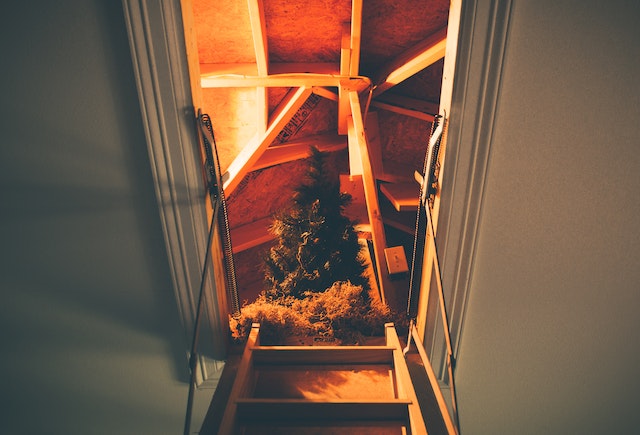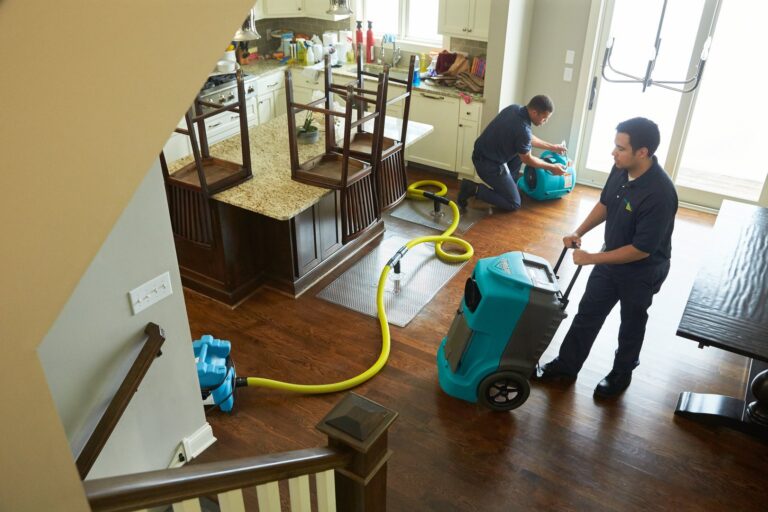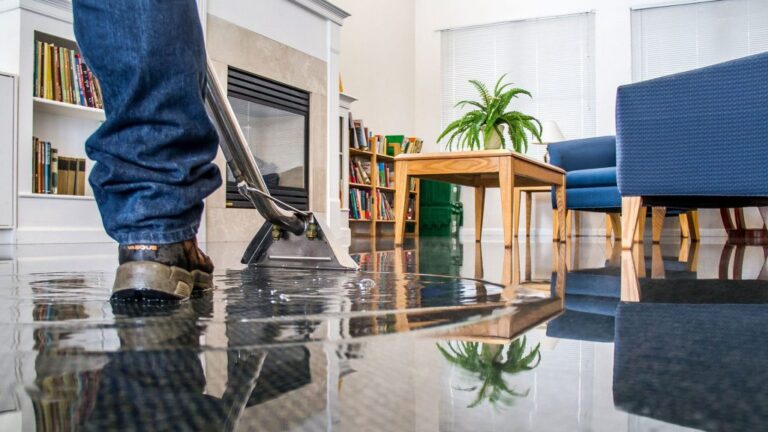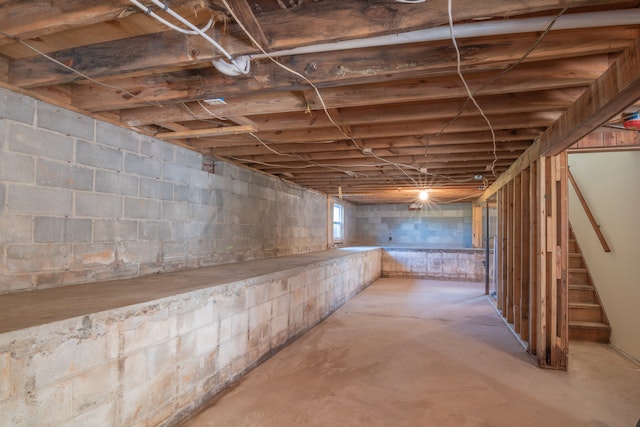Do you know what to do when your attic has water damage? Roof leaks or clogged gutters can both result in water damage in the attic. Prompt repairs and water cleanup is essential when dealing with a flooded attic to avoid excess moisture and mold growth.
This guide reviews the most common causes of water damage in the attic and provides a few tips to help with an efficient, timely cleanup.
What Causes Water Damage in Attics?
Water damage can arise from a number of causes, including:
- Clogged gutters
- Ice dams
- Roof leak
- Damaged shingles
- Freezing temperatures
- Broken water pipe
- Heavy condensation
- Melting snow
- Broken limbs damaging the roof
- Leaking roof valleys or roof joints from the installation of skylights or cables
- Ridge caps
How to Fix Water Damage in Your Attic Space
You can fix water damage in your attic with the following steps:
Contact a Restoration Company
One of the first calls to make after you notice a water-damaged attic should be to a restoration company. A professional restoration service helps guide you through the necessary cleanup steps after experiencing a flood. A few things Nashville Water Damage Restoration can help you with include the following:
- Documenting the damage to file an insurance claim.
- Salvaging your personal items.
- Collecting roof repair quotes from local professionals.
- Assisting you with the cleanup process.
Assess the Damage in Your Attic
One of the first things to do after you suspect attic damage is to determine its severity. Water stains are one of the first indications of water damage in the attic. You may notice water damage in a small portion of your attic or throughout the entire attic.
The attic is full of many nooks and crannies, making it important to check for water damage thoroughly. Make sure you move around your personal belongings in the attic to look for excess moisture or water damage. Another common place where you may find water is where the roof plates meet.
Identify the Source of the Roof Leak
Next, you’ll want to identify and stop the attic leak. You can track water droplets through the attic ceiling to find their source. You’ll need a flashlight to investigate the attic.
However, before exploring, make sure the water damaged attic is safe. Attic leaks can lead to wood rot, damaging the structural integrity of the floors and walls and making them dangerous.
The most common causes of water leaking in the attic are fixtures connected to the attic, including the chimney, plumbing systems, or roof vents.
Another commonly damaged area to check is where the vents protrude from the roof. You can also follow any drips upward until you locate the source of the water damage.
Get Quotes for Professional Help
Most attic leaks will require professional repairs and cleanup services. You may also require a plumber or roof contractor. If dripping water damages the electrical wiring in your attic, you’ll also need a licensed electrician.
Once a roof leak leads to damage in the attic, it usually means that the water has already made it into the ceiling and walls, meaning excessive moisture and structural damage is possible. At this point, it’s usually best to contact a professional as soon as possible. Your local restoration company can help you collect quotes to choose the best contractors.
Fix the Initial Leak – Create a Repair Plan
After identifying the source of the leak, it’s time to create a repair plan. Some homeowners may be able to fix minor leaks or repairs themselves. However, most homeowners will want to call a professional to repair the attic leak and prevent mold.
Even if you plan to utilize the services of a professional, you’ll want to temporarily fix the leak by turning off the water supply.
Depending on your DIY plumbing skills, you can apply putty or pipe tape to the burst pipe or roof leak to help control the water. You can also place buckets or tarps to catch some of the roof leakage.
Take Care of Initial Cleanup
Even if you plan on using a professional water remediation company, beginning the initial cleanup process can be helpful. Leaving standing water for too long can damage the attic’s structural integrity. It could also lead to mold.
Before beginning, you’ll want to remove all personal belongings from the attic space. Depending on the extent of the damage, you might outsource this big task to a professional company that can help salvage more of your items.
Remove standing water using a shop or wet/dry vacuum. Look closely for signs of mold or mildew growth. Mold is common following attic water damage because of the wet environment.
Remove Damaged Structural Components
A leak from roof damage often leads to damaged drywall and insulation. After completing the water removal step, you’ll need to remove all damaged structural components. Be sure to remove all other debris in the attic. The clear, clean space will make attic repairs easier to complete.
Contact Your Homeowners Insurance Provider
Homeowners insurance policies don’t always cover roof leaks. However, whether or not they’ll cover your insurance claim primarily depends on the cause.
For example, your insurance company may cover damage from weather, theft, or freezing conditions. Insurance companies in Tennessee are unlikely to cover gradual damage from a lack of maintenance or negligence.
How To Deal With Mold Growth in the Attic From Roof Leaks
Wet insulation or water from burst pipes can create the perfect environment for mold spores. Poor ventilation can spread mold spores throughout the attic and home, leading to respiratory symptoms.
Mold remediation in an attic often requires the expertise of a professional company. Getting all traces of mold is crucial to prevent it from spreading throughout the rest of the home.
How Can I Prevent Attic Water Damage?
You may be able to prevent some occurrences of attic water damage with the following tips:
Buy a Leak Detector
A leak detector can help you identify a potential attic or roof leak before it worsens. Leak detectors work by measuring pressure. If the pressure in the home rapidly changes, it could be due to flood damage in your attic space.
Ensure Proper Insulation
Attics that aren’t properly insulated collect air, leading to musty odors. Improper sealing also allows moisture from outdoors to make it inside, which can cause water-damaged attics.
Proper attic insulation is one of the best ways to avoid moisture buildup in your attic. The right amount of insulation is especially important if your appliances vent into the attic walls.
Install Vapor Barriers
Installing vapor barriers can also help to prevent attic condensation. Improving ventilation in the attic by using more attic vents can reduce the chances of mold.
Leave Repairs to a Professional
Allowing a licensed professional to make roof, HVAC system, and plumbing repairs can also help you avoid damage in the attic. Once you do suspect damage in the attic, prompt restoration services are a must.
Maintain Gutters and Downspouts
You can prevent leaks by properly maintaining gutters and downspouts. Water flows downhill, and blockages from leaves or ice dams in the gutters can cause them to back up.
Check the Roof Frequently for Damage
Loose shingles and damaged flashing can lead to roof leaks and, eventually, attic mold. Ensure you frequently trim tree branches to prevent them from puncturing the roof or causing damaged shingles.
Schedule routine roof inspections so you can make any necessary repairs before they lead to a water damaged attic.
What Does Attic Water Damage Look Like?
The most obvious sign of attic water damage is pools of water or rotted, moist wood.
Sometimes, you may also notice water signs, leaks, or holes in the roof. Roof leaks are often one of the biggest causes of attic floods. Some homeowners may also notice a musty smell in the attic.
Many homeowners also confuse water damage with condensation. High humidity levels can cause water droplets or condensation in the attic walls.
While condensation may not require as immediate repairs as a roof leak, it can still cause significant damage. Condensation in the attic should be controlled to avoid further damage.
You can usually identify water damage in your attic from discolored materials, mold, damp walls, water stains, corroded or rusted pipes, or stains on lower walls in the home. The moisture from the damage in your attic may even move through the rest of the home and impact its air quality.
Who Do I Call for a Water Leak in the Attic?
One of the first calls you should make after noticing a water leak in the attic is a restoration company. Depending on the cause of the attic leaks, you may require the services of a plumber, roofing contractor, or licensed electrician. By calling a restoration company first, you’ll have someone on your side who can help guide you through the process and choose the right contractors for your needs.
Bringing a restoration company in as early as possible also helps you control mold growth, which can minimize the extent of damage.
How Long Does It Take to Dry Out an Attic?
How long it takes to dry out an attic depends on the water source and the extent of the damage. The faster you can effectively dry out the attic, the better your chance of minimizing damages.
It takes just a few hours for mold to begin growing. Wet rafters and material mixed with the moist air of the average attic are the perfect breeding ground for mildew and mold.
How Must Does It Cost To Repair Attic Water Damage?
The average cost to repair water damage in the attic depends on a variety of factors, including what needs to be repaired, how long the water has been sitting, and the extent of the damage.
On average, repairing an attic with water damage costs between $45 to $55 per square foot. This doesn’t include roof repairs or water remediation services. You can expect to pay more for roof replacement, HVAC repairs, and water removal services.
Restoration projects that include simple roof repairs and minimal water pooling are on the lower end of the price range. However, if your roof suffers major damage and you have cracked flashing and soggy insulation with mold, you can expect to be at the higher end of the price range.
Homeowner’s insurance may cover some of these costs, depending on the cause of the water leak.
Contact a Tennessee Water Damage Restoration Company Today
Restoration professionals can help you pinpoint the source of water damage in your attic while also coming up with a plan to remediate and repair all damages.
Timely repairs are crucial to avoid mold and structural damage in your attic. Contact Nashville Water Damage Restoration today to deal with your flooded Tennessee attic.








